|
THE WORLD’S TOUGHEST ROW
The Atlantic
December 2024-January 2025
by Lieutenant Daragh MacDonagh
Coldstream Guards
|
On Tuesday 21st January 2025, the ‘Atlantic Explorers’ crossed the finish line of ‘The World’s Toughest Row - Atlantic’ in English Harbour, Antigua. The unassisted four-man crew was captained by myself, with three of my civilian friends, Sam Weston and Rex Fisher, from Dorset, and Ed Hughes, from Windsor. Clocking in at 41 days, 10 hours and 5 minutes, we faced the toughest conditions seen on the Atlantic in the last ten years. Below are extracts from my diary detailing the highs and lows of our epic journey.
Five years of planning is finally reaching its culmination! On Sunday 1st December 2024, we have arrived in La Gomera, Canary Islands, our starting point in the journey of a lifetime. Throughout our training and preparation years, we have been constantly motivated by honouring the memories of two of our friends who tragically took their own lives in separate incidents in 2018 and 2019. It is a poignant and emotional moment to know that our fundraising for Mind, the mental health charity, is still bringing in donations. I am also proud to be raising money for the Coldstream Guards Charity which does equally important work for fellow Coldstreamers. Three thousand miles west lies the Caribbean island of Antigua, our finish point. Right now, the distance seems overwhelming and almost insurmountable but, thankfully, there is no time to dwell. We have plenty of preparation to be getting on with.
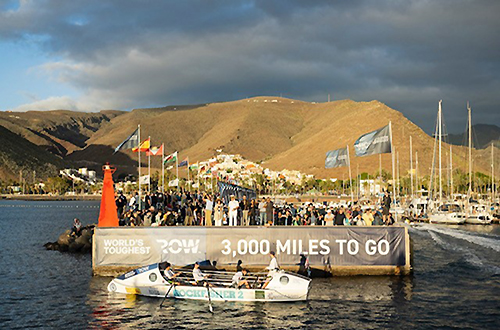 |
| A reminder of the distance to be travelled |
In the early hours of Monday 2nd December, we left our villa at the top of the volcanic island and made our way down to San Sebastian Harbour. The atmosphere was electric. 38 teams including solos, pairs, trios, fours and fives all gathered in an atmosphere of nervous excitement to hear from the Race Director. Inspiring videos and talks from previous rowers warned us of the brutal conditions we were soon to face but also displayed the beautiful wildlife out there and, of course, the epic finish line celebrations at the UNESCO World Heritage site Nelson’s Dockyard, Antigua. However, to be a part of those celebrations we were reminded of all that we needed to do in the nine days before the race start. Safety checks, comms checks, food checks, boat launching, practice rows, and tracker fitting all had to be squeezed into a hectic period.
Food preparation has soon become our most cumbersome task. We have transported 660 dehydrated meals here as well as a huge number of snacks including protein bars, dried fruit, nuts, and dehydrated meat. Now, we have to divide the food into twenty-four-hour bags containing 5500 calories each, the expected calorie expenditure per man per day. The most challenging aspect is managing conflict over the most popular dehydrated meals and ensuring the less attractive meals are allocated equally. There was a large number of vegetable stews left over towards the end of food packing…
With most of our preparation complete, on Friday 6th December we headed out into the Atlantic for the first time, albeit for a brief three-hour practice row. As part of our preparation, we had been ensuring the ‘trim’, the running angle of the boat, was at its optimal position. With the loaded boat weighing about one and a quarter tonnes, it is important to ensure the boat’s weight is distributed evenly to maximise speed. We slowly made our way out of the marina and were happy to have the oars back in our hands after a month-long hiatus. We ran our water-maker, a desalinating unit that would provide our drinking water at sea, to ensure it was functioning properly, and we tested all of our comms equipment with the safety team on shore. The sun was shining, the wind was kind, the trim felt good and all of our equipment was working faultlessly! Long may it continue…
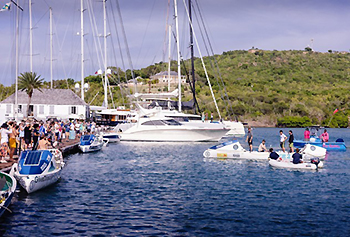 |
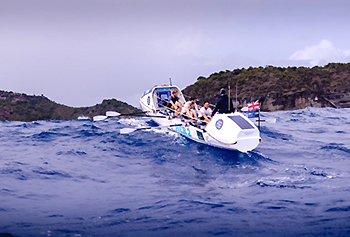 |
| Final preparations |
The first (small) wave |
On Wednesday 11th December, the day had finally come. A large embryonic vortex was forming off the coast so the start of the race was brought forward twenty-four hours to allow teams to try and avoid its full force. Thankfully we were prepared and so we stepped onto our boat in the early hours of the morning with a sense of contentment that we had finally made it but with trepidation about what was to come. As the sun rose, the hundreds of spectators who had come to wave us off from the harbour came into view. Media representatives from across the world collected our last words on their microphones before our mooring lines were released. Our families had made it to the highest point on the harbour and rattled their cowbells as we headed on to the high seas. There was an eerie silence on the boat as our families dropped out of view and we were faced with the prospect of only one another’s grating company for the next six weeks…
I had decided that we were going to row ‘three-up’ until the first sunset to utilise the ‘free energy’ given to us by our initial adrenaline. This would mean three people rowing at once leading to a pattern of three hours of rowing and one hour rest. And it was working! We edged our way in to fourth out of 38 teams within the first twelve hours and as the sun set, we settled in to our default pattern of ‘two-up’, two people rowing at once so a pattern of two hours rowing and two hours rest. As we headed into the second day, our weather router had interesting news. The vortex to our west was growing and therefore he directed us to head due south along the west coast of Africa to try and skirt around the bottom of the vortex. This would mean more miles to row but we would avoid dangerous stormy conditions. On the second night we witnessed an extraordinary display of green shooting stars zipping across the sky and an unidentified whale breaching right next to our boat. The extraordinary experiences we were promised were already here! The excitement of these moments, however, soon turned to misery as we began to be buffeted by strong easterly winds on the third day. In usual years, easterlies would be welcome as they would have pushed us towards Antigua. However, we were doing our utmost to avoid heading west at this stage because of the growing vortex. It was a doubly nightmarish situation; we were heading far south and therefore away from Antigua and we were not using the fabled easterly trade winds. We were in the middle of our first big morale dip and, as a soldier, it was incumbent on me to work hard for the maintenance of our collective morale.
Over the next few days, the conditions continued to conspire against us. The crosswinds were causing 30ft waves to crash over the boat, soaking all of us to the bone for the duration of our two-hour shifts on the oars. The waves became so aggressive at one point that Ed was swept overboard but he was harnessed on and so we hauled him back to his seat and shoved the oars back into his hands. There was little time to rest. Against the background of these brutal weather conditions, Sam was suffering from sea sickness. He rarely kept a meal down over the first seven days and became too nauseous inside the cabin, so he spent the entire time on deck including sleeping on a narrow slither of fibre glass whilst waves crashed onto him. The going was tough but the crew were biting down hard and performing admirably.
Halfway through the second week, we reached a position with a more southerly latitude than Antigua and which was below the vortex. We could now turn to our starboard side and point our bow in the general direction of Antigua. It was an enormous psychological boost but the Atlantic did not allow us to celebrate for too long. Even though fatigue was setting in, rowing was abnormally tough and the boat felt far heavier. We briefly rested our oars and began an investigation. We soon found three compartments full of water, and upon closer inspection found three holes in the bottom of the boat. Not only were our cabins filling with water, but much of our food was also compromised. There was little time to hang our heads. We sealed the holes with epoxy resin, discarded the food that had become inedible (whilst keeping all packaging on board) and went on our merry way.
Towards the end of the second week, we finally settled into a rhythm. The winds were now fairly benign and the boat was moving through the water nicely. We were kept company by migrating terns, Saharan sandstorms, and some beautiful sunsets. The skies shone gold and pink as if the heavens were beckoning us towards Antigua. The sea became calm enough for us to jump in and clean the hull. It was thrilling to be able to stretch out our bodies but a large shark circling the boat slightly curtailed our enjoyment. The third week brought one of the more interesting Christmases we have experienced. At 3am on Christmas morning we received a call on our radio from an American warship, asking who we were. The ship had spotted us via our automatic identification system but we didn’t show up on their radar so they questioned if we were a stealth boat out to cause trouble. We very quickly explained we were an innocent ocean rowing boat. They wished us a very jolly Christmas but sadly didn’t invite us aboard for mince pies and mulled wine! Instead, we popped on our Christmas hats, shared some tinned peaches and sang along to carols on the speaker. It was a welcome and cheerful respite from the drudgery of rowing.
As we grind into the final third of the race, we are all missing dry bed sheets. Our clothes and cabins are always slightly damp, if not soaking wet, and nothing ever dries. Everything is scratchy with salt on our skin. Despite vigorous cleaning, our bottoms are beginning to give in. When the saltwater dries on our clothing and seats it leaves salt crystals that drill themselves into our bottom cheeks and our blistered hands. We now have very red and angry welts all over our bodies. Sleep deprivation has also become extreme with the crew suffering from vivid hallucinations throughout the night. Strangely though, we have become fairly used to the rhythm of life at sea. At first, everything, even just moving about the boat, was difficult, but now it all seems pretty normal. Nevertheless, the Atlantic would never allow us the sin of becoming too comfortable. Fungal infections, vomiting and a broken finger or two kept us honest in our final stretch. With about 250 miles to go, our little isolated world suddenly became full of life. While the 40-degree heat attempted to sap us of the last of our energy stores, we were boosted by two passing superyachts honking their horns and shouting encouragement. A friendly minke whale swam alongside us for eight hours and so we decided to hop in and join it and birds came to sit on our boat. We enjoyed moments like these, knowing it was probably the only time we would experience them in our lives.
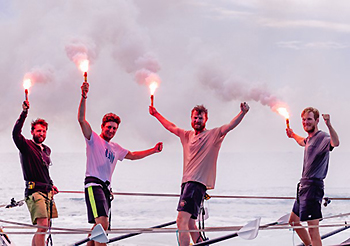 |
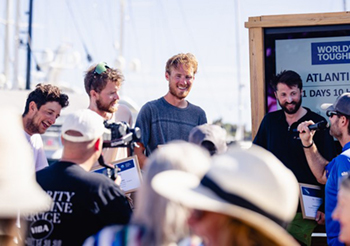 |
| The triumphant team |
On Tuesday 21st January 2025, we rowed into Nelson’s Dockyard, Antigua with our families and friends on Shirley Hill Fort cheering us in with flares. Dozens of yachts blared their horns and boats came out to meet and cheer us on in a moment of pure elation. We were suffering from a minor case of Stockholm Syndrome as the overwhelming nature of the arrival made the prospect of leaving our beloved boat quite alarming. The next few hours are a blur and are difficult to recall in any clarity. We have patched together memories of hugging our families, eating our first proper food, and media interviews. Surrounded by our family and friends, the ultimate feeling was one of ecstasy, made even better by being informed that donations to our charities had shot up whilst we are at sea.
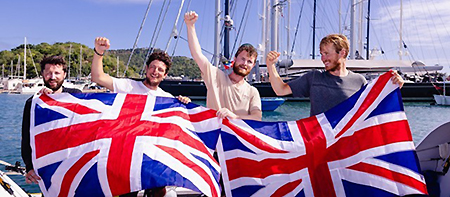 |
| We did it! |
Looking back at the videos I took on board, I promised myself never to undertake a similar challenge, but now that the dust has settled, the call of the oceans has returned. Plans are already underway to form a Coldstream team in 2028 to tackle the Pacific.
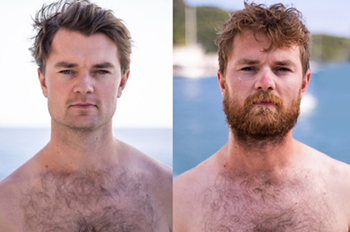 |
| The author – before and after |
|
|







